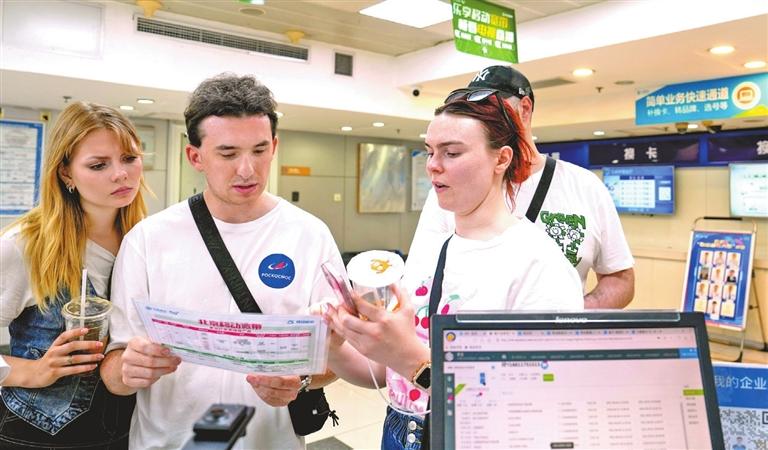





WEARING an elegant white dress, Umuhoza, a Rwandan businesswoman, took a photo in front of a smart photo device, which soon generated a photo depicting her as a valiant and noble woman with traditional Chinese features. “When people travel to China, they really want to take memories back home. The device can take a picture of you and then transform you into a Chinese kind of person. I really love it,” Umuhoza said. Umuhoza, who runs a travel website, helps tourists from Asian countries travel to African countries, including Rwanda, Egypt, and Tanzania. At the same time, her website has a “China package” that caters to travelers from Africa who want to visit China. She noticed that China is witnessing a surge in the use of smart technologies in its tourism industry, which has the potential to provide the growing number of international tourists with greater convenience and more immersive journeys. “That’s amazing. I am very interested in autonomous driving cars and many smart tourism scenes. Perhaps new trade cooperation can be carried out in the future,” Umuhoza said. Novel experience A wide range of innovative technologies have come into the spotlight in recent years, promising to unlock the competitiveness of Chinese tourism among global tourists. Just like Umuhoza, Elena Jitari-Parry, a full-time travel blogger from Moldova, was overwhelmed by the novel technologies adopted in China’s tourism sector when she attended the 2024 China Culture & Tourism Industries Exposition last month in northern China’s Tianjin Municipality. Putting on a virtual reality headset, Jitari-Parry was instantly transported to various places to experience the magnificent landscapes of China’s mountains and rivers. “So beautiful. It felt so authentic here,” she said. She also quickly learned about securing travel tips for exploring Tianjin via an intelligent tourism companion system, which simply requires a person to ask questions at a booth provided by Midu, a company focusing on artificial intelligence and large language models. “Traveling in China can be so easy for foreigners! The digitalization and intelligence services of Chinese tourist attractions have become a new trend, enabling foreigners like me to enjoy a more comfortable and convenient travel experience in China,” Jitari-Parry said. With the desire to further explore China, Jitari-Parry chose to be a full-time travel blogger and document her travels and experiences in China. “Foreigners are very interested in China’s technological development. I always advise my audience to come to China and see something different.” The deep integration of technology and the cultural tourism sector not only creates a variety of experiential tourism scenarios, but also meets people’s new needs for personalized travel, immersive experiences, and shopping for creative products. Data show that by the end of 2023, the scale of China’s digital cultural tourism market had exceeded 1 trillion yuan (US$140 billion), accounting for more than 30% of the entire cultural tourism industry. Smart services Drones and autonomous delivery vehicles operated by Meituan, one of China’s leading online services platforms, have received a lot of interest from international travelers. Ruben Diaz Jr., from the United States, was amazed by them. “Some of these things are brand new to me. Tourists can specify drones to deliver the items they need directly to the scenic areas, which is definitely more convenient.” Meituan said that it is currently operating more than 30 drone routes in cities such as Beijing, Shenzhen, Shanghai, and Guangzhou, completing over 300,000 orders in total. Thanks to the rapid development of smart tourism in China, tourists have become accustomed to using online payments and online ticket purchases during their travels. Data from iResearch, a research and consulting institute, show that in 2023, the total number of monthly uses and total usage time of online travel apps had grown by an average of more than 30% year on year. Some Chinese online travel service companies also use digital technologies to meet the growing travel needs of global visitors in China. In May, Tongcheng Travel launched an international travel reservation platform named HopeGoo, which supports payments in 16 global currencies and via various languages. The ability to make swift payments also has a significant impact on the overall experience of inbound tourists. To better cater to international visitors, WeChat Pay further streamlined its services this year by allowing inbound tourists to add international bank cards to their WeChat accounts. Tourists only need to enter their card number, expiration date, and security code — no identification information is required for transactions under US$2,000, according to Qin Tianxiong, a product manager of WeChat Pay's international card service. Richard Santana, a product designer and blogger from the United States, said that international tourists will be more willing to go to China with these online services and their travels in China will also be more convenient. New trend Ma Yiliang, chief statistician of the China Tourism Academy, said that “digitalization plus cultural tourism” has become a development trend. As “China Travel” became a hot social media topic globally, demand for inbound tourism to China increased significantly. In 2023, China recorded 82 million inbound tourist arrivals, and the country is expected to return to its 2019 visitor level by 2026, according to a green paper released by the Pacific Asia Travel Association (PATA) and the World Tourism Cities Federation. “With the smarter and more convenient experience in China, foreign tourists can find a more open, more confident, and safer China during their travels,” said Ma. There is an urgent need for China, a country with a rich and extensive history spanning over 5,000 years, to provide inbound tourists with a more interactive and engaging tourism experience, particularly for the younger generations, according to Peter Semone, chairman of PATA. Just displaying beautiful old cultural relics from thousands of years ago might result in aesthetic fatigue among inbound tourists, said Semone. “I think this is an opportunity for China to allow the tourists to start to engage a bit more in the culture,” he said. Semone added that China, with its vast market and extensive experience in managing a significant influx of tourists, has the potential to not only benefit from inbound travel but also export smart technologies to enhance tourism in other countries. (Xinhua) | 
